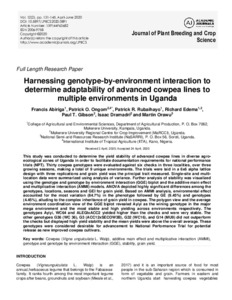| dc.contributor.author | Abiriga, F. |
| dc.contributor.author | Ongom, P.O. |
| dc.contributor.author | Rubaihayo, P.R. |
| dc.contributor.author | Edema, R. |
| dc.contributor.author | Gibson, P.T. |
| dc.contributor.author | Dramadri, I. |
| dc.contributor.author | Orawu, M. |
| dc.date.accessioned | 2022-04-25T09:16:26Z |
| dc.date.available | 2022-04-25T09:16:26Z |
| dc.date.issued | 2020-04 |
| dc.identifier.citation | Abiriga, F., Ongom, P.O., Rubaihayo, P.R., Edema, R., Gibson, P.T., Dramadri, I. & Orawu, M. (2020). Harnessing genotype-by-environment interaction to determine adaptability of advanced cowpea lines to multiple environments in Uganda. Journal of Plant Breeding and Crop Science, 12(2), 131-145. |
| dc.identifier.issn | 2006-9758 |
| dc.identifier.uri | https://hdl.handle.net/20.500.12478/7432 |
| dc.description.abstract | This study was conducted to determine the yield stability of advanced cowpea lines in diverse agro-ecological zones of Uganda in order to facilitate documentation requirements for national performance trials (NPT). Thirty cowpea genotypes were evaluated against six checks in three localities, over three growing seasons, making a total of 9 unique environments. The trials were laid in a 6x6 alpha lattice design with three replications and grain yield was the principal trait measured. Single-site and multi-location data were summarized using analysis of variance. Further analysis of stability was visualized using the genotype and genotype by environment interaction (GGE) biplot and the additive main effect and multiplicative interaction (AMMI) models. ANOVA depicted highly significant differences among the genotypes, locations, seasons and GEI for grain yield. Based on AMMI analysis, environmental effect accounted for the most variation (84.7%) in the phenotype followed by GE (9.45%) and genotypes (4.45%), alluding to the complex inheritance of grain yield in cowpea. The polygon view and the average environment coordination view of the GGE biplot revealed Ayiyi as the wining genotype in the major mega environment and the most stable and high yielding across environments respectively. The genotypes Ayiyi, WC64 and ALEGIxACC2 yielded higher than the checks and were very stable. The other genotypes G36 (WC 36), G3 (ACC12xSECOW3B), G32 (WC16), and G14 (MU9) did not outperform the checks but displayed high yield stability and the mean yields were above the overall average. These genotypes were considered desirable for advancement to National Performance Trial for potential release as new improved cowpea cultivars. |
| dc.format.extent | 131-145 |
| dc.language.iso | en |
| dc.subject | Cowpeas |
| dc.subject | Vigna Unguiculata |
| dc.subject | Genotypes |
| dc.subject | Environment |
| dc.subject | Stability |
| dc.subject | Yields |
| dc.subject | Uganda |
| dc.subject | genotype environment interaction |
| dc.title | Harnessing genotype-by-environment interaction to determine adaptability of advanced cowpea lines to multiple environments in Uganda |
| dc.type | Journal Article |
| cg.contributor.crp | Grain Legumes |
| cg.contributor.affiliation | Makerere University |
| cg.contributor.affiliation | National Semi Arid Resources Research Institute, Uganda |
| cg.contributor.affiliation | International Institute of Tropical Agriculture |
| cg.coverage.region | Africa |
| cg.coverage.region | East Africa |
| cg.coverage.country | Uganda |
| cg.identifier.bibtexciteid | ABIRIGA:2020 |
| cg.isijournal | ISI Journal |
| cg.authorship.types | CGIAR and developing country institute |
| cg.iitasubject | Agribusiness |
| cg.iitasubject | Agronomy |
| cg.iitasubject | Cowpea |
| cg.iitasubject | Genetic Improvement |
| cg.iitasubject | Grain Legumes |
| cg.iitasubject | Plant Breeding |
| cg.iitasubject | Plant Genetic Resources |
| cg.iitasubject | Plant Production |
| cg.journal | Journal of Plant Breeding and Crop Science |
| cg.notes | Open Access Article; Published online: 31 May 2020 |
| cg.accessibilitystatus | Open Access |
| cg.reviewstatus | Peer Review |
| cg.usagerightslicense | Creative Commons Attribution 4.0 (CC BY 0.0) |
| cg.targetaudience | Scientists |
| cg.identifier.doi | https://dx.doi.org/10.5897/jpbcs2020.0891 |
| cg.futureupdate.required | No |
| cg.identifier.issue | 2 |
| cg.identifier.volume | 12 |

